Fresh from their recently-announced bankruptcy and acquisition by Toshiba, OCZ’s newest consumer-grade SSD makes a bold statement during the company’s important transition phase, aiming to provide a value-minded SSD solution while simultaneously catering to the enthusiast with high performance needs. The OCZ Storage Solutions Vertex 460 is a mainstream SSD that takes advantage of the new partnership by marrying OCZ’s Barefoot 3 M10 controller with Toshiba 19nm MLC NAND technology, providing a product that benefits from quality engineering and the lower operational costs that stem from the work of a strong collaborative team. This is a major boon for OCZ, both in terms of finance and technology, and the Vertex 460 can be rightly considered a positive indication of things to come from the company.
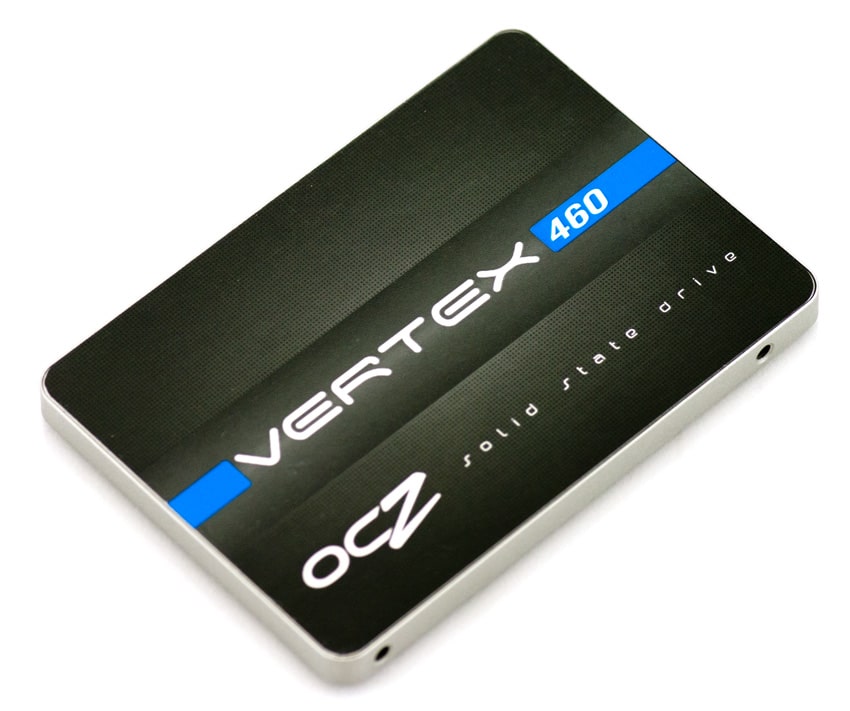
The Vertex 460 is designed for mainstream users that who require a high-performance SSD. The drive sports a 2.5″ 7mm slim form factor, and ships with a 3.5″ adaptor for those who wish to use the drive for desktop upgrades. The unit also ships with an Acronis cloning software key for added value, and sports Windows 8 compatibility.
Overall, the Vertex 460 is a modest improvement over its predecessor, the Vertex 450. The two units sport the same Barefoot 3 M10 controller and endurance rating of 20GB/day over 3 years under typical workloads. In some cases, however, the new Toshiba NAND technology allows the 460 to outshine its older brother in the manufacturer’s internal benchmarks: greatly increased write IOPS and max write for the lower-capacity (120GB) model, as well as vastly superior sustained performance across the board — 12000 vs. 3000 IOPS for the 120GB model, 21000 vs. 7000 IOPS for the 240 GB model, and 23000 vs. 7000 IOPS for the 480GB model. Our review unit is the 240GB capacity.
OCZ Vertex 460 SSD Specifications
- Capacities
- 120GB
- 240GB
- 480GB
- Controller: Barefoot 3 M10
- NAND Component: Toshiba 19nm MLC Flash
- Interface: SATA 3.0 6Gb/s
- Form Factor: 2.5″, 7mm
- Encryption: 256-bit AES compliant
- Product Health Monitoring: Self-Monitoring, Analysis and Reporting Technology (SMART)
- Endurance: Rated for 20GB/day of host writes for 3 years under typical workloads
- Power Consumption
- Idle: 0.6W
- Active: 2.70W
- Operating Temperature: 0~70 C
- Shock Resistance: 1500G/0.5ms
- Vibration
- Operational: 2.17Grms (7-800Hz)
- Non-Operational: 16.3Grms (20-2000Hz)
- Warranty: 3 years
Design and Build
The Vertex 460’s design isn’t a major departure from that of its predecessors. The entire top side of the drive is covered by the Vertex label, while the rest of the unit is smooth, minimalistic, and pleasing to the eye. On the obverse side is a standard information label, providing the user with everything he or she needs to know (serial numbers, model, PNs, etc).
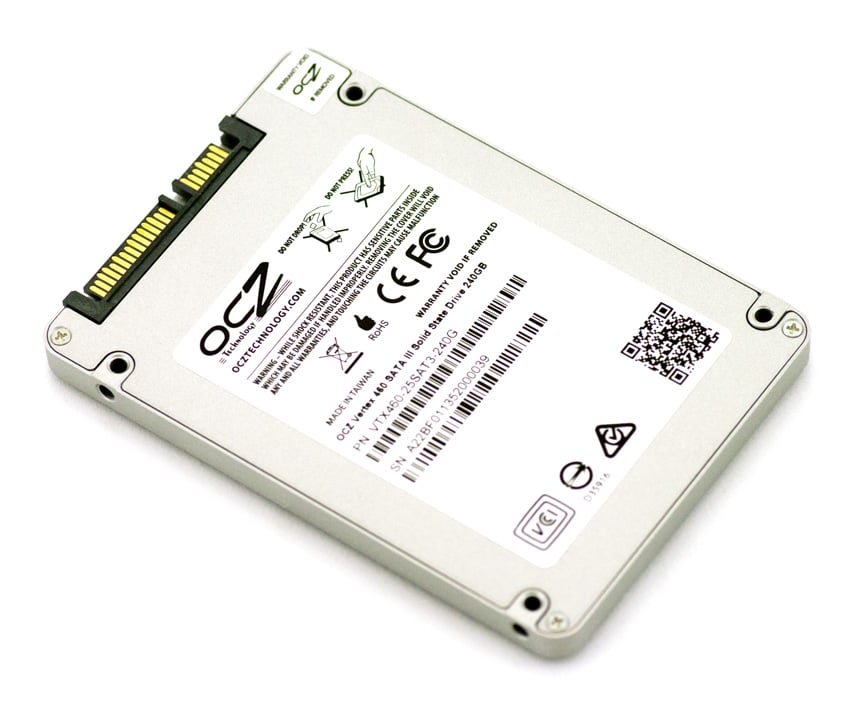
With its 7mm 2.5-inch form-factor, the OCZ Vertex 460 can be installed in virtually any platform; from an ultraportable notebook to even embedded solutions and flash arrays that utilize consumer SSDs. The front of the SSD has a standard SATA power and data interface, with all service and firmware upgrade functions handled through the OCZ Toolbox.
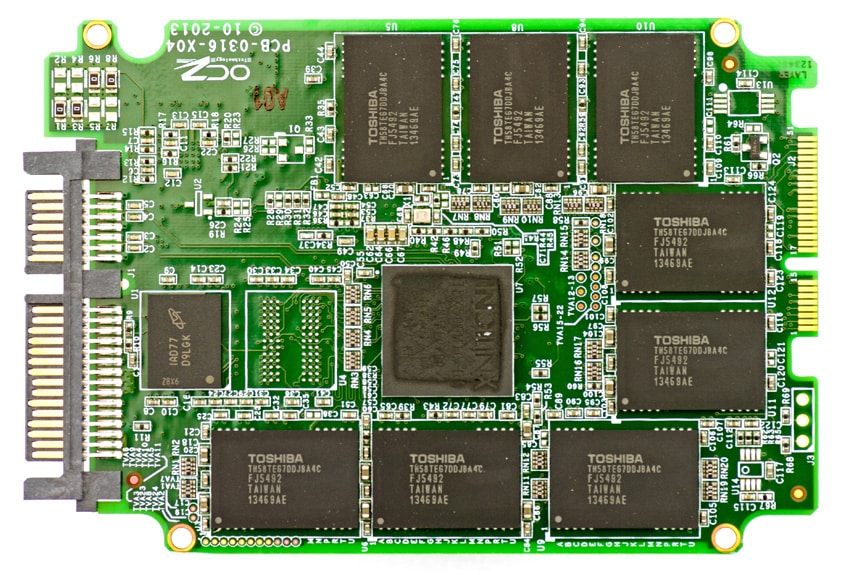
To open, simply remove the four small Phillips head screws from the four corners of the bottom cover. Next, carefully pry up the cover, which is held on partially by a thermal pad OCZ uses to dissipate heat off of the controller into the body of the case. With the cover removed, you can see the OCZ Indilinx Barefoot 3 controller at the heart of the Vertex 460 SSD.
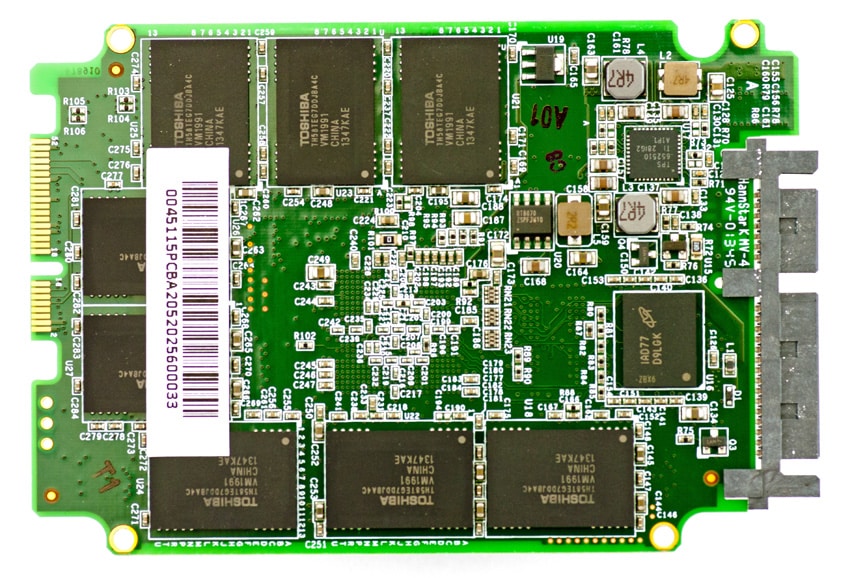
Consumer Synthetic Benchmarks
All consumer SSD benchmarks are conducted with the mid-range StorageReview Consumer Testing Platform. The comparables used for the review below include:
- OCZ Vector 256GB
- Seagate 600 240GB
- Crucial M500 480GB
- Samsung SSD Evo 250GB
- OCZ Vector 150 240GB
- Intel SSD 530 240GB
- OCZ Vertex 450 256GB
All IOMeter figures are represented as binary figures for MB/s speeds.
Our first test measuring 2MB sequential performance placed the OCZ Vertex 460 in line with the other units tested in terms of read activity, registering 494.617MB/s, an improvement of 10 MB/s over the Vertex 450 (though in general, the difference in read performance between the various drives only falls within a margin of roughly 20 MB/s). In terms of write performance, all of the OCZ branded drives distinguish themselves ahead of the rest, with the OCZ Vertex 450/460 and OCZ Vector 150 all writing at pretty much the same speed of around 480MB/s. Only the OCZ Vector 256MB clocked better write speeds, just ahead of the pack at 489.84MB/s.
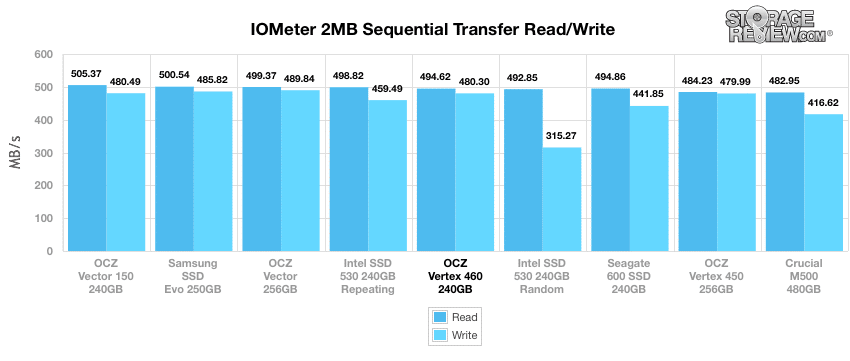
For the 2MB random transfer benchmark, the Vertex 460 still narrowly beats out the 450 at 442.57MB/s read, though this is the third lowest overall read speed across all comparables. In terms of write speed, the Vertex 460 performs better: roughly identical to the Vertex 450, but ahead of every other comparable except the OCZ Vector series drives at 478MB/s.
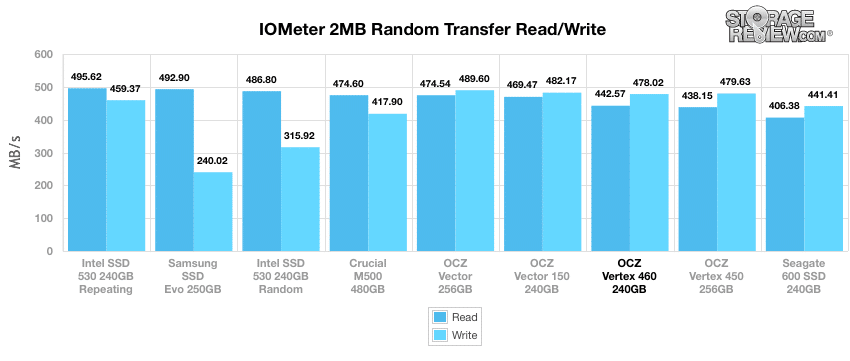
Our third test measures smaller random transfers at the 4K level. The results here are similar to the previous random test: in terms of read speed, the Vertex 460 comes in second-last at 23.96MB/s. The Vertex 460 makes up for it in write performance though at 78.44 MB/s. As before, the OCZ drives tested lead the pack.
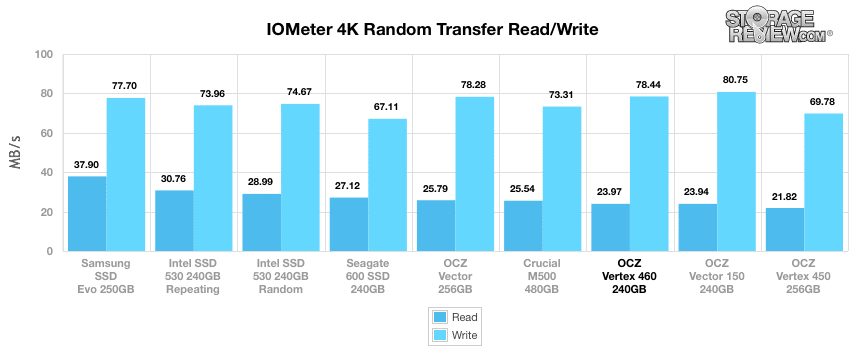
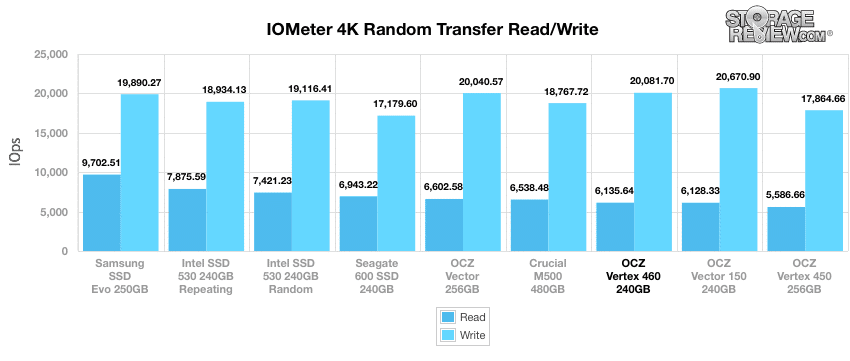
The next benchmark remains at 4K 100% read activity, but scales the queue depth from 1 to 64 in an effort to demonstrate how the drive will react under increasing workloads. The Vertex 460 remained near the bottom of the pack until the 12QD level, when it overtook the Intel drives to finish at 84,520 IOPS at a thread queue depth of 64.
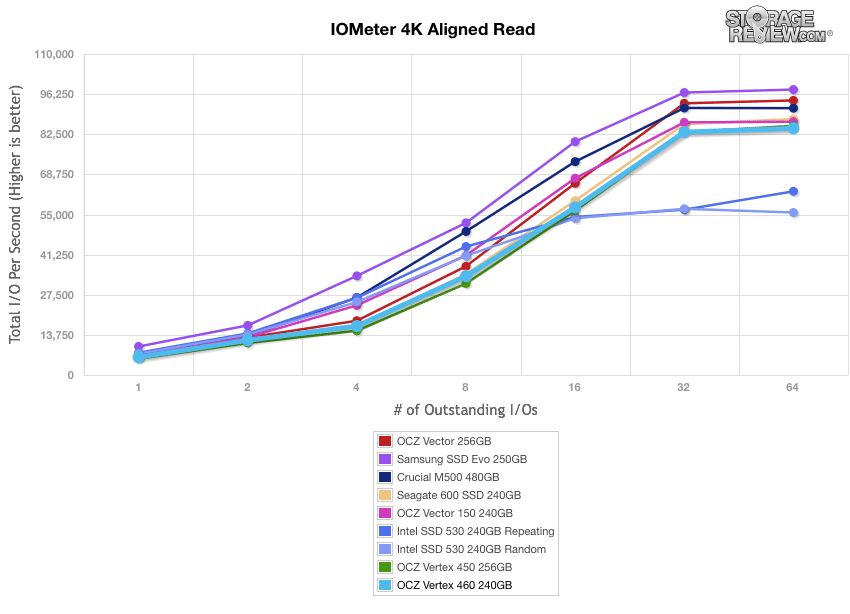
Switching to 4K 100% write activity across the same spectrum of queue depths, the Vertex 460 continues its trend of stability, being topped only by the Samsung at the 64 queue level. This is a good example of the Vertex 460’s overall tradeoff of read speed in exchange for write speed in an effort to remain as balanced and consistent as possible.
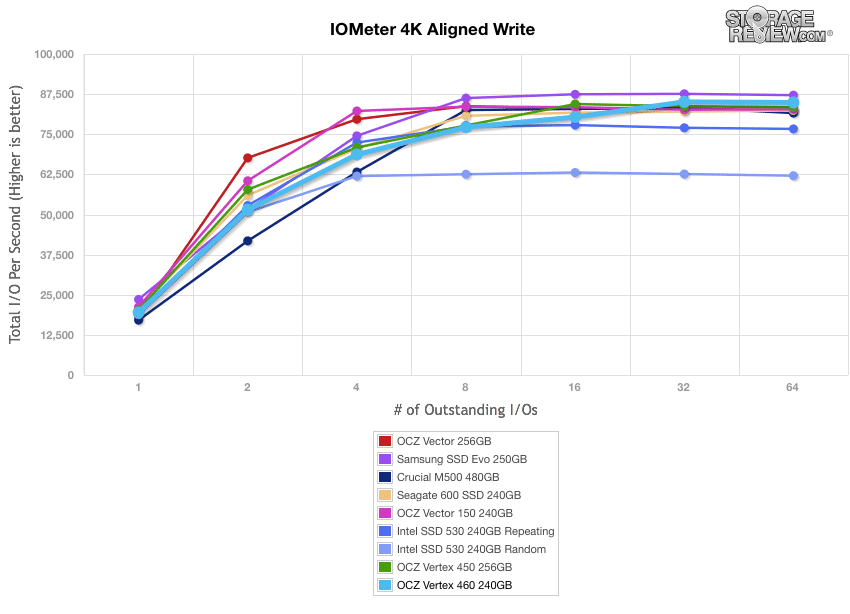
Comparing average write latency between the tested drives, we find that the Vertex 460 comes out on the faster side of average at 4.9ms, while maximum latency came in at 333ms. While the OCZ drives in general all measured maximum latency that was quite a bit higher than the other comparables, the Vertex 460 held its own among its cousins, roughly equalling the max latency of the OCZ Vector 150.
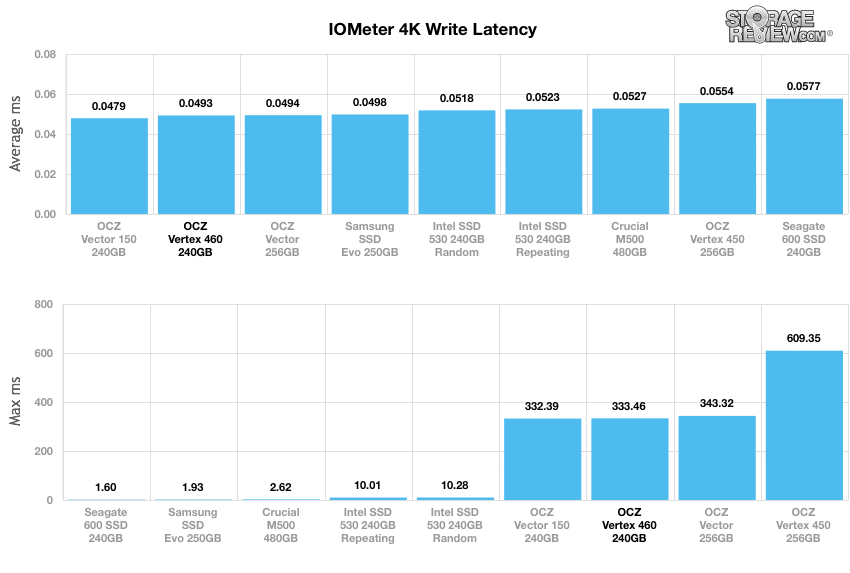
Our last series of synthetic benchmarks compare the hard drives in a series of server mixed-workloads with a queue depth of ranging from 1 to 128. Each of our server profile tests has a strong preference towards read activity, ranging from 67% read with our database profile to 100% read in our web server profile.
Our first profile models database performance with a 67% read/33% write mix with a transfer size of 8K. In this test, the other OCZ drives slightly outperformed the Vertex 460, though in general all of the OCZ drives ranked ahead of the Samsung, Intel, Seagate, and Crucial competitors.
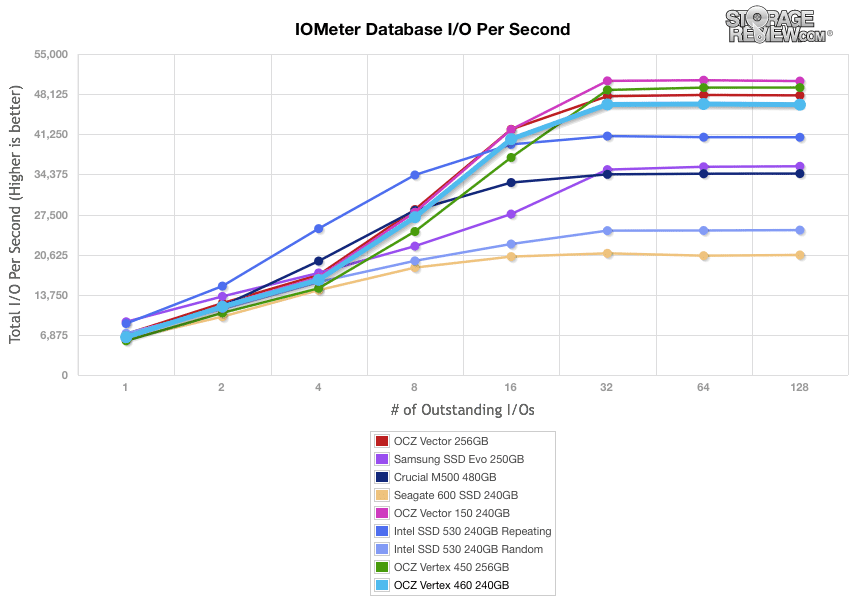
The second profile is in the file server role, with 80% read/20% write activity with multiple transfer sizes ranging from 512byte to 64KB. Here, the Vertex 460 turned middling performance at lower queue depths into a strong third-best finish at 32KB and above, beaten only by the OCZ Vector drives (which were functionally identical).
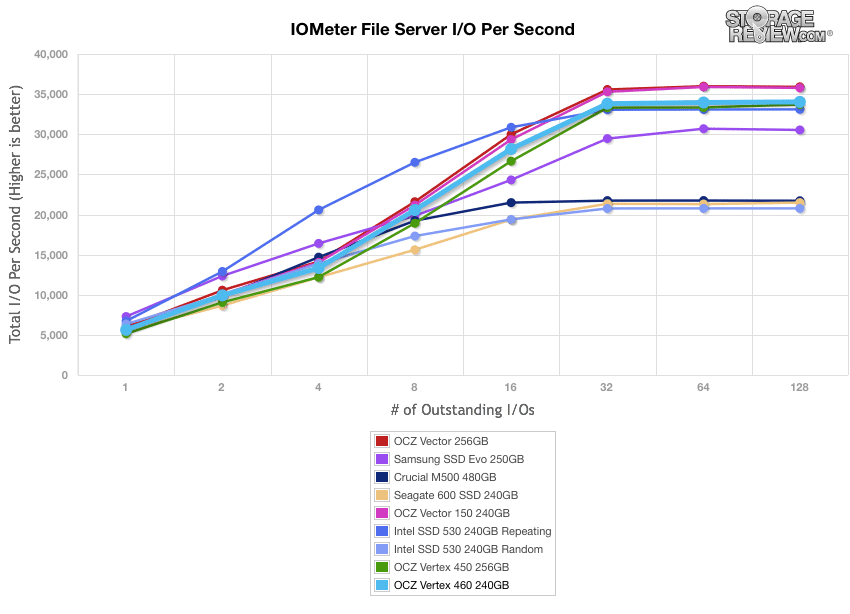
Our web server profile is read-only with a spread of transfer sizes from 512-byte to 512KB. Here, the Vertex 460 consistently ran in the middle of the pack, always slightly ahead of the Vertex 450 but behind the OCZ Vector drives, as well as the Seagate and Samsung.
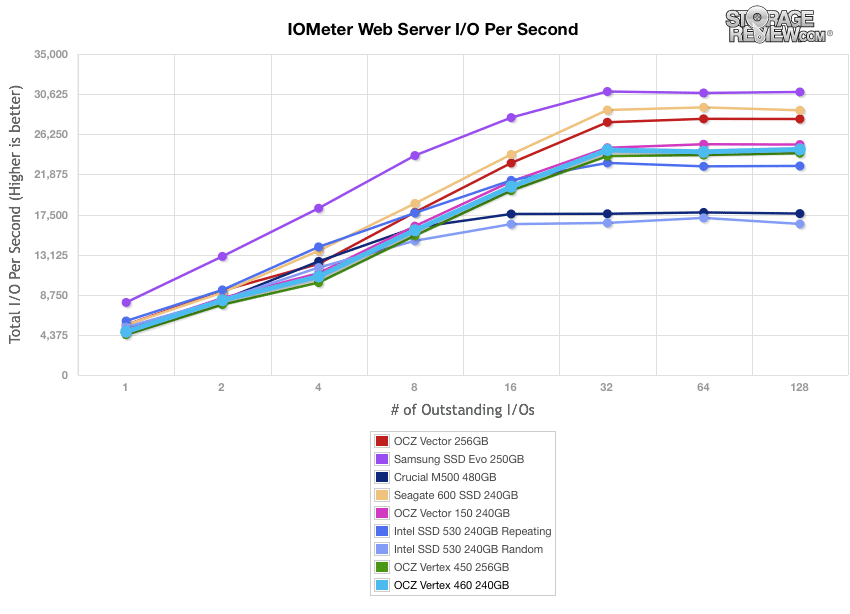
The last profile looks at a workstation, with a 20% write and 80% read mixture using 8k transfers. The Vertex 460 came again in the middle of the pack for most queue depths, but above 8QD all of the OCZ drives started outperforming their counterparts. In the end, the Vertex 450 and 460 were functionally identical, outperformed only by the two Vector models.
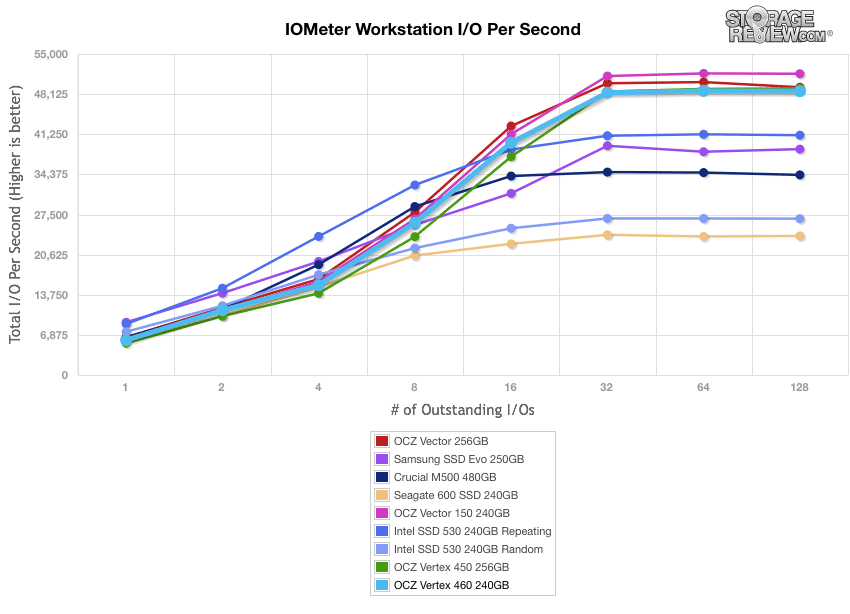
Consumer Real-World Benchmarks
The average customer is likely going to have a difficult time translating random 4K write speeds and hard data into something understandable and practical. It helps when comparing drives in every setting possible, but it doesn’t exactly work out into faster everyday usage or better game loading times. For this reason we turned to our StorageMark 2010 traces, which include HTPC, Productivity, and Gaming traces to help readers find out how a drive might rank under these conditions.
Our first test of real-life circumstances is the HTPC profile. For the sake of this test, the following activities are performed in order to simulate the activity of a home theater PC in a consumer household setting: playing one 720P HD movie in Media Player Classic, one 480P SD movie playing in VLC, three movies downloading simultaneously through iTunes, and one 1080i HDTV stream being recorded through Windows Media Center over a 15 minute period. In a setting such as this, higher IOps and MB/s transfer rates mean better performance overall.
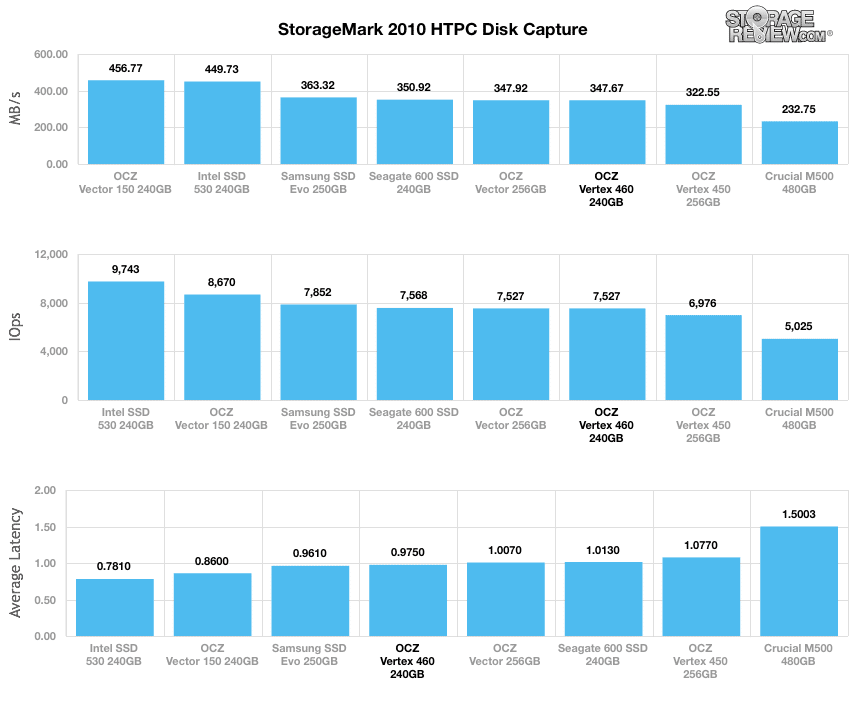
Using this HTPC profile, the Vertex 460 performed firmly in the middle of the group at 7527 IOps alongside the OCZ Vector 256GB, Samsung SSD Evo, and Seagate SSD 600. In terms of MB/s, the results were similarly middling at 347.67 MB/s with an average latency of 97ms.
The second real-life testing regimen attempts to gauge performance based on a simulation of normal everyday personal or business computer use. In an attempt to model this, the test includes: a three hour period operating in an office productivity environment with 32-bit Vista running Outlook 2007 connected to an Exchange server, web browsing using Chrome and IE8, editing files within Office 2007, viewing PDFs in Adobe Reader, and an hour of local music playback with two hours of additional online music via Pandora.
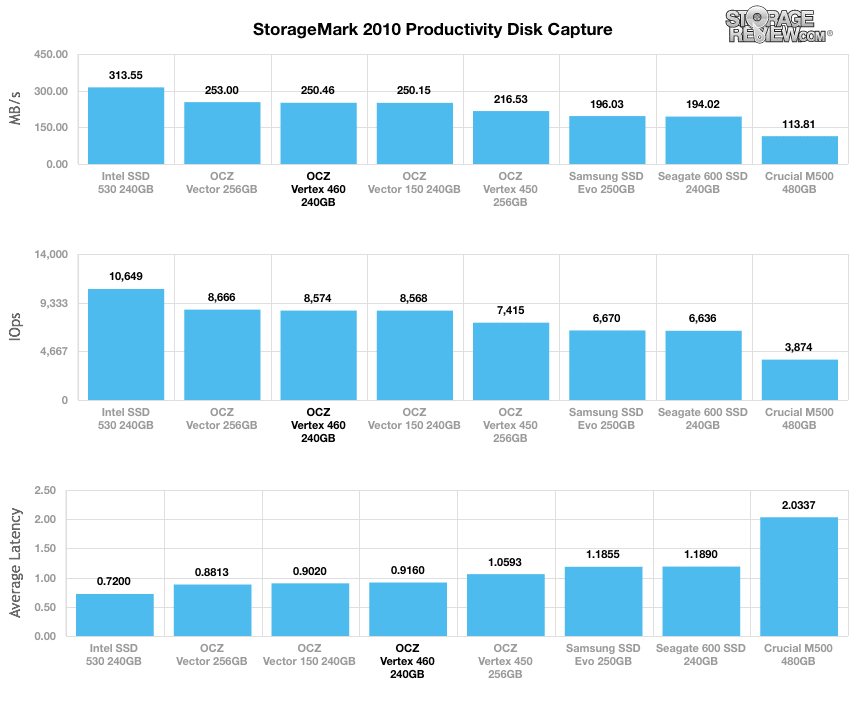
In the productivity testing profile, the Vertex 460 recorded roughly the same IOps as the two OCZ Vector drives at 8573 IOps and 250.4MB/s, beaten only by the Intel SSD 530.
Our third real-life test covers disk activity in a gaming environment. Unlike the HTPC or Productivity trace, this one relies heavily on the read performance of a drive. To give a simple breakdown of read/write percentages, the HTPC test is 64% write, 36% read, the Productivity test is 59% write and 41% read, while the gaming trace is 6% write and 94% read. The test consists of a Windows 7 Ultimate 64-bit system pre-configured with Steam, with Grand Theft Auto 4, Left 4 Dead 2, and Mass Effect 2 already downloaded and installed. The trace captures the heavy read activity of each game loading from the start, as well as textures as the game progresses.
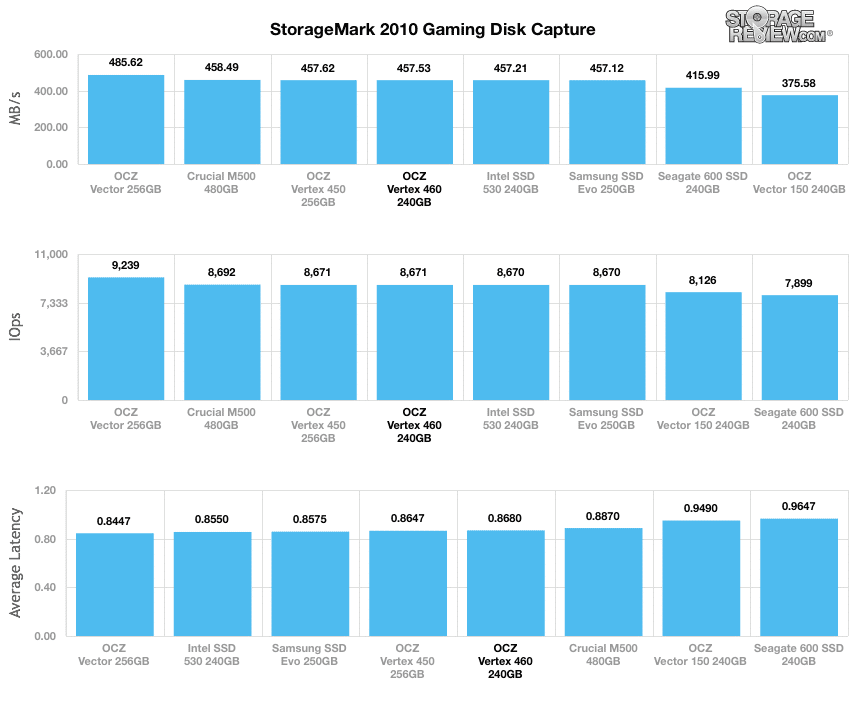
In the gaming trace, the Vertex 460 performs well at 8670 IOps and 457.5 MB/s, being basically identical to four of the other drives, and beaten only by the OCZ Vector 256GB.
Power Consumption
As is generally the case with laptop drives or with consumers who seek greener solutions, low power consumption is a critical goal. As such, this test compares average power consumption across a range of our synthetic benchmarks in an effort to demonstrate consumption under several circumstances. For the sake of comparison, we’ve also recorded the results for the slightly older Vertex 450.

Overall, the Vertex 460 consumes less power than the older 450 in all cases, with the notable exception of startup consumption. In some cases the difference is negligible (random read, idle), while others are more dramatic.
Conclusion
The OCZ Vertex 460 is designed and marketed with one major goal in mind, and it fulfills it well, providing a no-nonsense, value-minded SSD that doesn’t skimp on efficiency or high performance. The collaboration between OCZ and new owner Toshiba has produced an effective marriage of two well-engineered technologies: the OCZ Barefoot 3 controller with Toshiba’s 19nm MLC flash NAND. To this end, the drive is able to deliver a higher performance at a lower overall production cost, as the link between OCZ and Toshiba is direct — a win for everyone involved, including the consumer. With the Vertex 460’s 2.5″, 7mm form factor and included 3.5″ adapter, the drive is fits seamlessly in nearly any laptop or desktop PC environment.
In nearly every test we performed, the Vertex 460 is a modest improvement over the Vertex 450, and in some cases has performance that comes close to matching OCZ’s Vector series (which is aimed at the enthusiast rather than mainstream consumer). In most of the cases where the Vertex 460 is outperformed, it is by its cousins in OCZ’s Vector line. While in some cases the Vertex 460 posts more mediocre results befitting its affordable price and target demographic, our consumer benchmarks indicate that it performs consistently above other competitors in its class in a productivity or gaming role.
In the end, the Vertex 460 is an exciting new SSD offering that has a lot to say about the direction OCZ Storage will be going under ownership of Toshiba. In the case of the Vertex 460, combining teams and technologies has resulted in a superior product at a lower operational cost, and makes for a solid continuation of the OCZ product line after its recent acquisition by Toshiba.
Pros
- Performance improvements on the Vertex 450
- In some cases, approaches the high performance of drives aimed at enthusiasts rather than mainstream consumers
- Direct line of supply to the Toshiba NAND, cutting costs
Cons
- Small block random reads lag a little
Bottom Line
The OCZ Vertex 460 is a great indicator of the positive course being charted in OCZ’s new future with Toshiba, accomplishing what it sets out to do: provide a value-minded, high-performance SSD for the mainstream consumer.
OCZ Vertex 460 at AmazonDiscuss This Review




 Amazon
Amazon